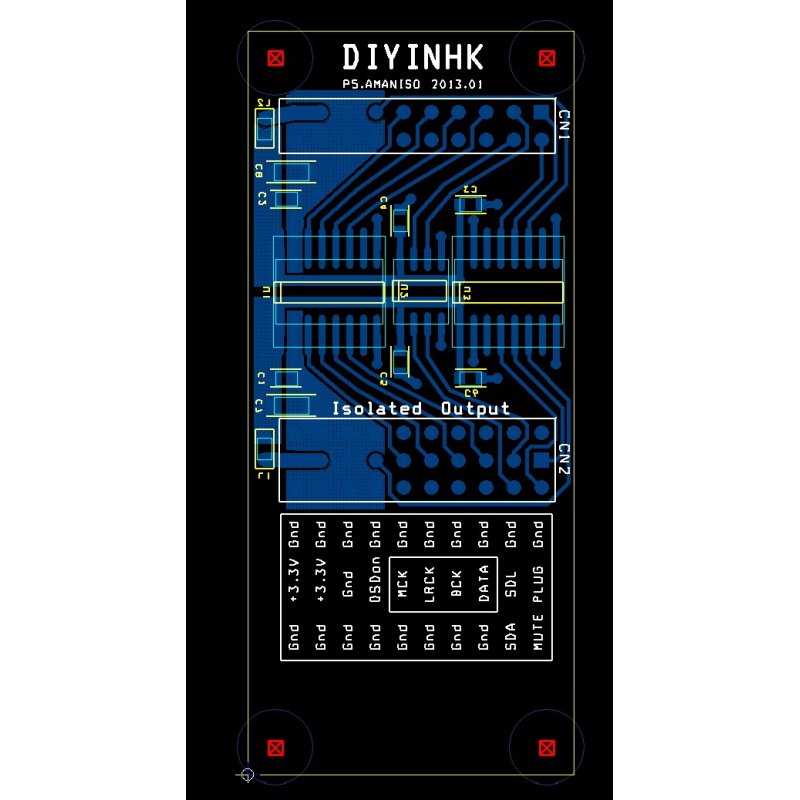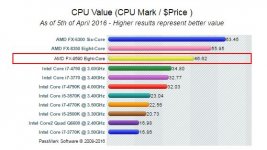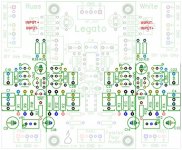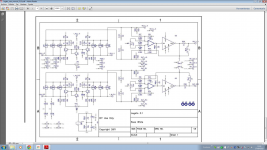The thread has been quiet for a couple of days, I guess you're all busy with your soldering irons?
Anyway, I expect the additional boards to arrive fairly soon so if anyone from the initial GB hasn't received their boards if you drop me a PM we can try and sort something out.
After that is sorted I'll make any remaining boards available to latecomers.
Ray
Maybe they all went to the pub 😛 That's what I did 😀
Hope you can send the pcb's very soon, can't wait to get started 😉
Hi All,
been following this thread with great interest and have bought this PCB........
Newest Xmos U8 USB 384K 32B Module I2S SPDIF Output Support DSD for ES9018 DAC | eBay
I am getting DSD O/P OK once filtered but am getting some audible Noise on top of the Audio (White Noise-ish) which makes it unlistenable really.
I am using Foobar on Windows 7 with some DSD Files downloaded from the 2L site and Blue Coast Records.
I have tried straight out of the PCB (Filtered of course) and with the Flip-Flop (Filtered after the Transformer) but still the noise persists.
Any thoughts would be gratefully received.
been following this thread with great interest and have bought this PCB........
Newest Xmos U8 USB 384K 32B Module I2S SPDIF Output Support DSD for ES9018 DAC | eBay
I am getting DSD O/P OK once filtered but am getting some audible Noise on top of the Audio (White Noise-ish) which makes it unlistenable really.
I am using Foobar on Windows 7 with some DSD Files downloaded from the 2L site and Blue Coast Records.
I have tried straight out of the PCB (Filtered of course) and with the Flip-Flop (Filtered after the Transformer) but still the noise persists.
Any thoughts would be gratefully received.
I use free DIYINHK I2S isolator and don't hear any kind o noise.
Free Amanero Isolator bare PCB Twin pack - DIYINHK

Free Amanero Isolator bare PCB Twin pack - DIYINHK

Another good thing is not use the self powered usb-I2S board, I use dedicated PSU not shared with I2S isolator.
I have tried powering from an external PSU but what about the 0 Volt connection? I can still see noise on that, whether it is that that I'm hearing I'm not sure.
Your Isolation PCB looks like a good suggestion. I'll try that.
Many thanks.
Your Isolation PCB looks like a good suggestion. I'll try that.
Many thanks.
Hi All,
been following this thread with great interest and have bought this PCB........
Newest Xmos U8 USB 384K 32B Module I2S SPDIF Output Support DSD for ES9018 DAC | eBay
I am getting DSD O/P OK once filtered but am getting some audible Noise on top of the Audio (White Noise-ish) which makes it unlistenable really.
I am using Foobar on Windows 7 with some DSD Files downloaded from the 2L site and Blue Coast Records.
I have tried straight out of the PCB (Filtered of course) and with the Flip-Flop (Filtered after the Transformer) but still the noise persists.
Any thoughts would be gratefully received.
What DSD rate are you using? What LP filter? I assume your recordings are native DSD (dsf files)?
You've put your own project together so it might be a good idea to sketch out the schematic(s) you're using?
Do you have any pictures of your installation?
I seem to recall someone earlier in the thread having problems with the same, or similar, board but hopefully this will turn out well for you, though I would have been inclined towards purchasing an Amanero or JLSounds board as a starting point that is known to work with this approach.
Ray
Hi,
thanks for the reply.
I am using DSD64 and DSD128, my PC won't go as high as DSD256.
At DSD64 though the Sample Rate is 2.8MHz (?) well outside the Audio Band so my Filter (4th Order (Butterworth(?)) 47mH, 560pF (to Ground) ,4.7mH, 7k5 (to Ground)) which starts to roll off around the 34kHz 40kHz mark should be enough to get rid of this (?). I used nL5 software to design the filter. (A very useful programme)
The Output from the USB PCB has been connected to the filter mentioned above or I've tried it into the Flip-Flop design found within this thread. Admittedly it is built on Strip-Board but no matter how I shield it or move it away from the 'Analogue' section the noise remains constant. I would expect to hear or scope some change as the PCB is moved if the Strip-Board was an issue.
I think you're right in that I probably should have gone for the Amanero PCB or the JL Sounds one as these have been tested on here. My bad!
thanks for the reply.
I am using DSD64 and DSD128, my PC won't go as high as DSD256.
At DSD64 though the Sample Rate is 2.8MHz (?) well outside the Audio Band so my Filter (4th Order (Butterworth(?)) 47mH, 560pF (to Ground) ,4.7mH, 7k5 (to Ground)) which starts to roll off around the 34kHz 40kHz mark should be enough to get rid of this (?). I used nL5 software to design the filter. (A very useful programme)
The Output from the USB PCB has been connected to the filter mentioned above or I've tried it into the Flip-Flop design found within this thread. Admittedly it is built on Strip-Board but no matter how I shield it or move it away from the 'Analogue' section the noise remains constant. I would expect to hear or scope some change as the PCB is moved if the Strip-Board was an issue.
I think you're right in that I probably should have gone for the Amanero PCB or the JL Sounds one as these have been tested on here. My bad!
If it were me I would leave the i5 and look for a used workstation with a Xeon processor; Xeon are more optimised for number crunching processing than the i5/i7 ranges (because they don't have the on-chip video etc.).
I would aim for a processor that benchmarks at around 8000+. Here's a site with processor benchmarks;
https://www.cpubenchmark.net/high_end_cpus.html
I have a Xeon E3 1240 3.3GHz processor which benchmarks at 7974 and comfortably upsamples CD rips to DSD256.
Check out the used commercial kit resellers in Spain
Ray
Performance divided by price:
Attachments
Performance divided by price:
Your forgetting this;
I posted you some info about the PC I use a couple of weeks back; I'm using a reconditioned HP Z210 workstation that only cost me about £200...
There seemed to be far more suitable reconditioned/used Intel-based PCs available than AMD ones, other than that I can't get too excited about who made the CPU.
Hi,
thanks for the reply.
I am using DSD64 and DSD128, my PC won't go as high as DSD256.
At DSD64 though the Sample Rate is 2.8MHz (?) well outside the Audio Band so my Filter (4th Order (Butterworth(?)) 47mH, 560pF (to Ground) ,4.7mH, 7k5 (to Ground)) which starts to roll off around the 34kHz 40kHz mark should be enough to get rid of this (?). I used nL5 software to design the filter. (A very useful programme)
The Output from the USB PCB has been connected to the filter mentioned above or I've tried it into the Flip-Flop design found within this thread. Admittedly it is built on Strip-Board but no matter how I shield it or move it away from the 'Analogue' section the noise remains constant. I would expect to hear or scope some change as the PCB is moved if the Strip-Board was an issue.
I think you're right in that I probably should have gone for the Amanero PCB or the JL Sounds one as these have been tested on here. My bad!
You have a lot of variances to what I've been using successfully so its difficult to know what the issue is. How about implementing a simple first order filter that has been known to work in other projects as a next step? If you still have the noise present I think the finger of suspicion points more towards the USB board.
Where are you in the UK? I might be able to loan you a JLSounds board for a couple of days?
BTW, I had a quick look at a filter something like that you describe in the Tubecad filter software; I'm no technical expert in these matters but it looks more like a third order filter and the values are different?
Ray
I have tried powering from an external PSU but what about the 0 Volt connection? I can still see noise on that, whether it is that that I'm hearing I'm not sure.
Your Isolation PCB looks like a good suggestion. I'll try that.
Many thanks.
The 0 volt connection must be shared self powered or external powered or the USB don't work.
.......................Where are you in the UK? I might be able to loan you a JLSounds board for a couple of days?.........
That's a very kind offer but after a bit more investigation I am convinced it is the PCB. I have isolated it to a particular Track (I think) carrying the DSD Clock which is radiating badly and the noise ends up on the Analogue Signal. Adding a 15pF to Ground helps but doesn't cure. Neither does cutting Tracks and re-routing. Badly designed PCB(?).
...............BTW, I had a quick look at a filter something like that you describe in the Tubecad filter software; I'm no technical expert in these matters but it looks more like a third order filter and the values are different?.....................
I think I was counting Components rather than 'Knees'. After a little more reading I think you may be correct, thanks for the pointer.
That's a very kind offer but after a bit more investigation I am convinced it is the PCB. I have isolated it to a particular Track (I think) carrying the DSD Clock which is radiating badly and the noise ends up on the Analogue Signal. Adding a 15pF to Ground helps but doesn't cure. Neither does cutting Tracks and re-routing. Badly designed PCB(?).
The offer is still there if you do want to try it to confirm the issue is with your USB board.
At least some progress though.
Keep the digital connections nice and short too.
Ray
@Ray
Finally I got music in both channel using the Flip Flop but mixed with high white noise in both channels, at the beginning of the thread some people mentioned the psu powering the Flip Flop can modulate the signal and I suspect also is the same that I have because when used SE sounds without any kind of noise. I'm using to power the Flip Flop a Salas Reflektor shunt regulator specially designed for powering digital so I ask Salas if it's possible to add something at the regulator to filter the white noise.
Felipe
Finally I got music in both channel using the Flip Flop but mixed with high white noise in both channels, at the beginning of the thread some people mentioned the psu powering the Flip Flop can modulate the signal and I suspect also is the same that I have because when used SE sounds without any kind of noise. I'm using to power the Flip Flop a Salas Reflektor shunt regulator specially designed for powering digital so I ask Salas if it's possible to add something at the regulator to filter the white noise.
Felipe
@Ray
Finally I got music in both channel using the Flip Flop but mixed with high white noise in both channels, at the beginning of the thread some people mentioned the psu powering the Flip Flop can modulate the signal and I suspect also is the same that I have because when used SE sounds without any kind of noise. I'm using to power the Flip Flop a Salas Reflektor shunt regulator specially designed for powering digital so I ask Salas if it's possible to add something at the regulator to filter the white noise.
Felipe
I'm not convinced it's the power supply - the Salas Reflektor is a very stable low noise power supply.
Can you post a picture of your implementation.
I don't have very long this evening as I'm on my way out but on a quick cursory glance;
The connections from the isolator to the FF board are very long and unscreened. The FF PCB layout deliberately keeps the digital paths very short when it's plugged onto the JLSounds board and I suggest you need to do something similar.
You need to twist output wires s from the FF board and possibly screen them. They'll act like aerials as they are.
Ray
The connections from the isolator to the FF board are very long and unscreened. The FF PCB layout deliberately keeps the digital paths very short when it's plugged onto the JLSounds board and I suggest you need to do something similar.
You need to twist output wires s from the FF board and possibly screen them. They'll act like aerials as they are.
Ray
- Home
- Source & Line
- Digital Line Level
- The Best DAC is no DAC



![WP_20160408_001[1].jpg](/community/data/attachments/510/510697-201a6caf1bcb8cf3d88b974e0e0be34d.jpg?hash=IBpsrxvLjP)
![WP_20160408_002[1].jpg](/community/data/attachments/510/510708-e30955ce83d45ac39f0d538248a949a7.jpg?hash=4wlVzoPUWs)